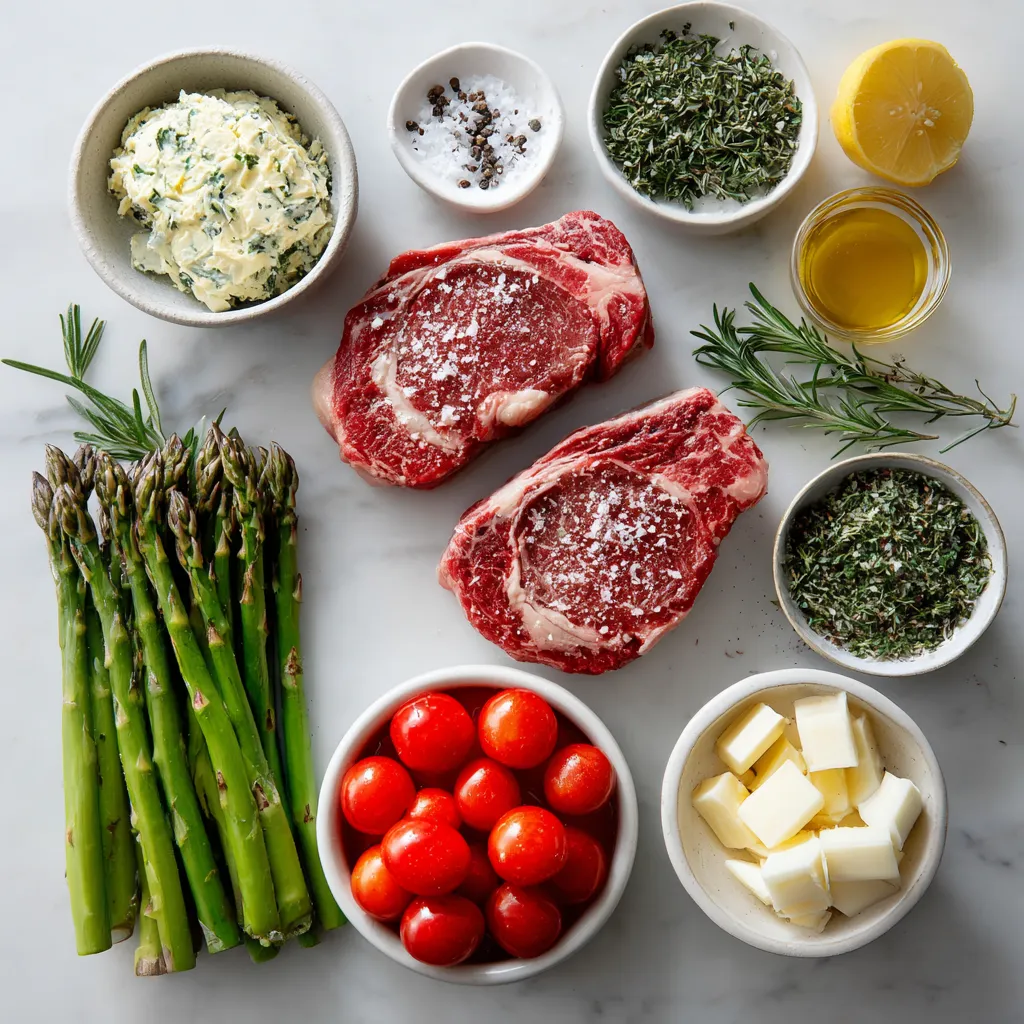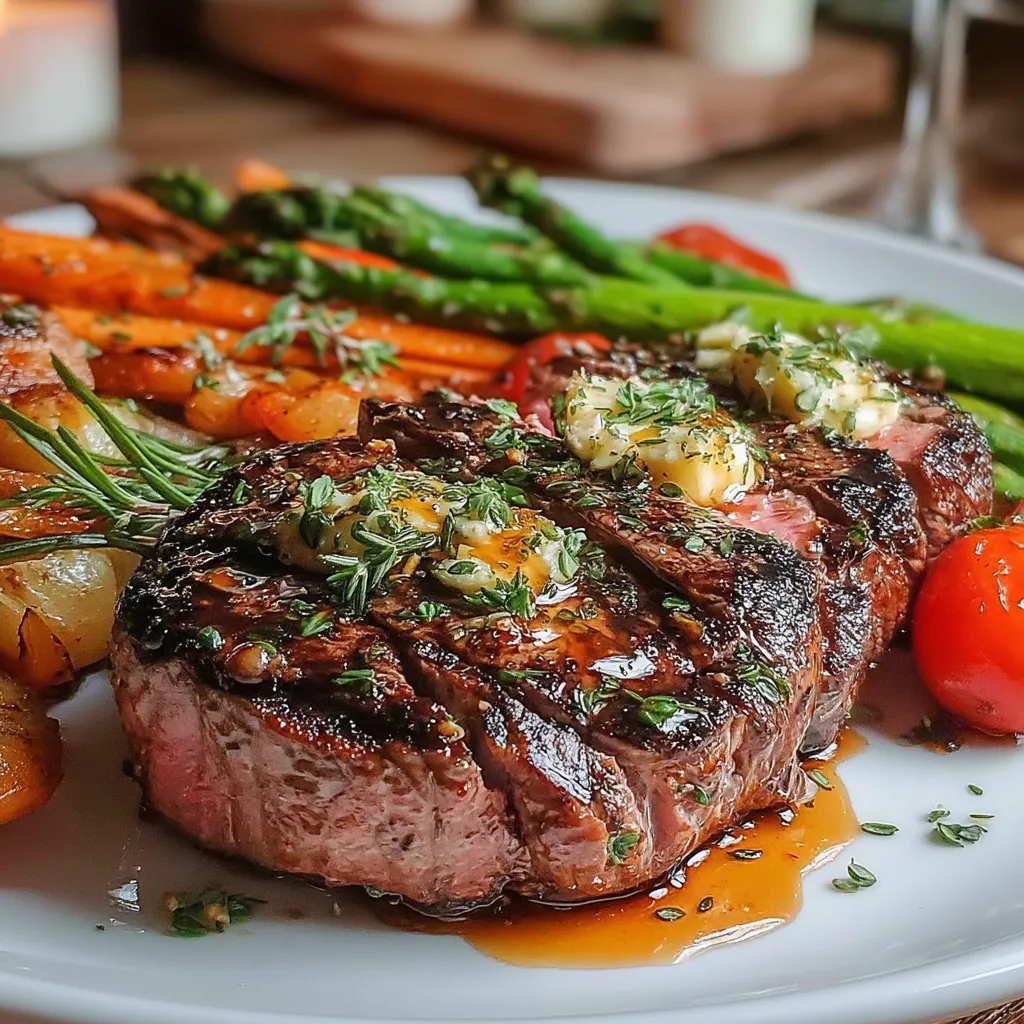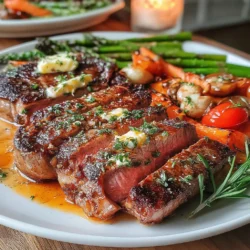Introduction
Herb Butter Seared Steak with Seasonal Veggies is a delightful and nutritious choice for dinner that promises to impress. This dish combines the rich, juicy flavors of perfectly cooked steak with vibrant, fresh vegetables, creating a meal that is as visually appealing as it is delicious.
The aromatic herb butter elevates the flavors even further, making each bite a savory experience. Whether it’s a weeknight meal or a special occasion, this recipe stands out, ensuring you and your guests will savor every moment around the dinner table.
Recipe Overview
– Total Time: 30 minutes
– Servings: 4
– Difficulty: Easy
Ingredients
– 2 ribeye steaks (1-inch thick)
– Salt and pepper, to taste
– 2 tablespoons olive oil
– 1 tablespoon unsalted butter
– 4 tablespoons herb butter (see below for recipe)
– 2 cups seasonal vegetables (e.g., asparagus, bell peppers, zucchini)
– 2 cloves garlic, minced
– Fresh herbs for garnish (optional)

Instructions
1. Allow the ribeye steaks to come to room temperature for about 30 minutes before cooking. Season generously with salt and pepper on both sides.
2. In a large skillet, heat the olive oil over medium-high heat until shimmering.
3. Add the ribeye steaks to the skillet and sear for 4-5 minutes on the first side, undisturbed, until a golden brown crust forms.
4. Flip the steaks and add the unsalted butter and minced garlic to the pan. Cook for an additional 4-5 minutes, basting the steaks with the melted butter.
5. During the last minute of cooking, add the herb butter to the skillet, allowing it to melt and infuse its flavors into the steaks.
6. Remove the steaks from the skillet and let them rest for at least 5 minutes.
7. In the same skillet, add the seasonal vegetables and sauté for 3-4 minutes until tender but still crisp. Season with salt and pepper to taste.
8. Serve the steaks with the sautéed vegetables on the side, garnished with fresh herbs if desired.
Understanding the Ingredients
Overview of the Main Components
– Steak: The star of the dish is the ribeye steak, known for its rich flavor and tenderness.
– Herb Butter: This adds a luscious, aromatic element that enhances the meat’s natural flavors.
– Seasonal Veggies: Fresh vegetables not only add color but also provide essential nutrients and a crisp texture.
Choice of Ribeye Steak
Ribeye steak is favored for its marbling, which contributes to its juicy and robust flavor. The thickness of the cut ensures even cooking, while various cooking methods, such as searing, enhance its natural qualities.
Benefits of Using Fresh, Seasonal Vegetables
Incorporating seasonal vegetables enhances not just the nutrition but also the flavor and presentation of the dish. Fresh produce is often at its peak during its season, providing vibrant colors and tastes that complement the richness of the steak.
Crafting the Perfect Herb Butter
Ingredients and Their Roles
– Unsalted butter: Serves as the base, allowing the herbs to shine without added saltiness.
– Fresh herbs: Common choices include parsley, thyme, and rosemary, each contributing its unique aroma and flavor.
– Garlic: Adds depth and enhances the overall taste profile of the butter.
Step-by-Step Guide
1. In a medium bowl, combine softened unsalted butter with finely chopped fresh herbs, minced garlic, salt, and pepper.
2. Mix until well blended and smooth.
3. Transfer the mixture onto a piece of plastic wrap, shape it into a log, and twist the ends to seal.
4. Chill in the refrigerator until firm, about 1 hour.
Importance of Fresh Herbs
Using fresh herbs is crucial for achieving maximum flavor impact in the herb butter. Dried herbs can lack the vibrancy and aroma that fresh ones offer, resulting in a less appealing flavor profile.
Selecting the Right Steak
Choosing the Best Cut
When selecting steak for searing, ribeye stands out due to its tenderness and rich flavor compared to other cuts. Other good options include sirloin or filet mignon, but ribeye is often preferred for its marbling.
Steak Thickness and Marbling
A thickness of at least 1 inch ensures that the steak cooks evenly, while good marbling contributes to tenderness and flavor. Look for steaks with a good amount of white fat interspersed throughout the meat.
Properly Seasoning Steak
Before cooking, generously season the steak with salt and pepper to enhance its natural flavors. This simple step is key to achieving a delicious crust and flavorful interior.
Cooking Techniques: Searing the Steak
Searing is a high-heat cooking technique that creates a flavorful crust on the steak while sealing in moisture. This method is essential for achieving that restaurant-quality finish at home, making your Herb Butter Seared Steak a standout dish.

Tips for Cooking the Perfect Steak
Understanding the Searing Process
Searing is essential for developing a rich, flavorful crust on your steak. The high temperature of the pan creates a Maillard reaction, which enhances the steak’s natural flavors and locks in juices. To achieve the perfect sear, ensure your skillet is preheated until it’s smoking hot before adding the steak. This not only helps in creating that desirable crust but also minimizes the time the meat spends in the pan, preserving its moisture and tenderness.
Importance of Letting the Steak Rest
After cooking, it’s crucial to let your steak rest for at least 5-10 minutes. This resting period allows the juices to redistribute throughout the meat, ensuring even doneness and preventing them from spilling out when you cut into it. Skipping this step can result in a dry steak, diminishing the overall quality of your dish.
Cooking to Desired Doneness
To achieve your preferred level of doneness, utilize visual cues and timing as a guide:
– Rare: 120°F (about 2-3 minutes per side)
– Medium Rare: 130°F (about 3-4 minutes per side)
– Medium: 140°F (about 4-5 minutes per side)
– Medium Well: 150°F (about 5-6 minutes per side)
– Well Done: 160°F and above (about 6-7 minutes per side)
Use a meat thermometer for accuracy, and keep in mind that the steak will continue to cook slightly as it rests.
Sautéing Seasonal Vegetables
Preparing and Seasoning Vegetables
Selecting fresh, seasonal vegetables not only enhances the flavor of your dish but also contributes vital nutrients. Before sautéing, wash and cut the vegetables into uniform sizes for even cooking. A simple seasoning of olive oil, salt, and pepper can elevate their natural flavors. Consider adding garlic or shallots for an extra kick.
Health Benefits of Seasonal Vegetables
Incorporating a variety of vegetables into your meals provides numerous health benefits. Seasonal veggies are often fresher, more flavorful, and retain more nutrients. They are rich in vitamins, minerals, and antioxidants which support overall health and wellbeing while complementing the protein from the steak.
Sautéing for Tenderness and Caramelization
To sauté vegetables effectively:
1. Heat olive oil in a skillet over medium-high heat.
2. Add your vegetables in batches, starting with those that take longer to cook, like carrots or broccoli.
3. Stir frequently to ensure even cooking, allowing them to caramelize slightly for flavor, while still maintaining their vibrant color.
4. Cook until tender but not mushy, about 5-7 minutes.
Plating and Presentation
Creating a Visually Appealing Plate
Presentation plays a key role in the enjoyment of your meal. Start by placing the steak in the center of the plate. Arrange the sautéed vegetables around the steak, creating a colorful and inviting display.
Garnishing for Added Flair
For a finishing touch, garnish your dish with freshly chopped herbs like parsley or a sprinkle of lemon zest. This not only adds visual interest but also complements the flavors of the dish.
Balancing the Plate
Achieving balance between the steak and vegetables is important for an inviting meal appearance. Ensure that the colors and shapes of the vegetables contrast well with the steak, making the dish more appealing to the eye.
Nutritional Benefits of the Dish
Analyzing Nutritional Components
This Herb Butter Seared Steak with Seasonal Veggies is a well-rounded meal. Ribeye steak is rich in protein and healthy fats, providing essential amino acids and energy. The addition of herb butter introduces flavor while keeping the dish moist.
Vitamins and Antioxidants from Vegetables
Seasonal vegetables add a wealth of vitamins and antioxidants to your plate. They contribute dietary fiber, which aids digestion, and various vitamins such as A, C, and K, which are important for immune health, skin, and bone health, respectively.
Encouraging Balanced Eating
Incorporating this dish into a varied diet promotes balanced eating. It’s a great way to enjoy a hearty meal while ensuring you’re getting a good mix of macronutrients and micronutrients.
Conclusion
Herb Butter Seared Steak with Seasonal Veggies is a delightful meal that combines rich flavors and textures, making it a crowd-pleaser for any occasion. The process of cooking is rewarding, from the sizzling sound of the steak in the pan to the vibrant colors of the sautéed vegetables.
This recipe’s versatility allows it to fit various dietary preferences, whether you’re serving it for a special celebration or a cozy weeknight dinner. Embrace the joy of cooking and the satisfaction that comes from serving a delicious, homemade dish that nourishes both body and soul.

Herb Butter Seared Steak with Seasonal Veggies
Ingredients
- 0.5 cup unsalted butter, softened
- 2 cloves garlic, minced
- 1 tablespoon fresh rosemary, finely chopped
- 1 tablespoon fresh thyme, finely chopped
- 1 zest lemon
- 2 boneless ribeye steaks steaks
- 2 tablespoons olive oil
- 0.25 teaspoon salt
- 0.25 teaspoon freshly ground black pepper
- 3 tablespoons unsalted herb butter
- 1 cup asparagus, trimmed
- 1 cup cherry tomatoes, halved
- 1 red bell pepper sliced
- 1 tablespoon olive oil
- 0.25 teaspoon salt
- 0.25 teaspoon pepper
Instructions
- Prepare the Herb Butter: In a small bowl, combine the softened butter, minced garlic, rosemary, thyme, lemon zest, salt, and pepper. Mix until well combined. Transfer the herb butter onto a piece of parchment paper, roll it into a log, and twist the ends tightly. Chill in the refrigerator for at least 30 minutes until firm.
- Prepare the Veggies: In a large bowl, toss the asparagus, cherry tomatoes, and red bell pepper with olive oil, salt, and pepper. Set aside.
- Cook the Steaks: Remove the steaks from the refrigerator and let them sit at room temperature for about 30 minutes before cooking. Heat a large skillet over medium-high heat and add the olive oil. Season both sides of the steaks generously with salt and pepper. Once the oil is shimmering, add the steaks. Sear for about 4-5 minutes on each side for medium-rare (adjust time according to desired doneness). During the last minute of cooking, add the chilled herb butter to the skillet and spoon the melted butter over the steaks.
- Sauté the Veggies: While the steaks rest (about 5 minutes), return the skillet to medium heat if needed, and add the seasoned veggies. Cook for about 5-7 minutes, stirring occasionally, until the veggies are tender and slightly caramelized.
- Serve: Slice the rested steaks and serve alongside the sautéed veggies. Drizzle any remaining herb butter from the skillet over the top. Enjoy your culinary masterpiece!
